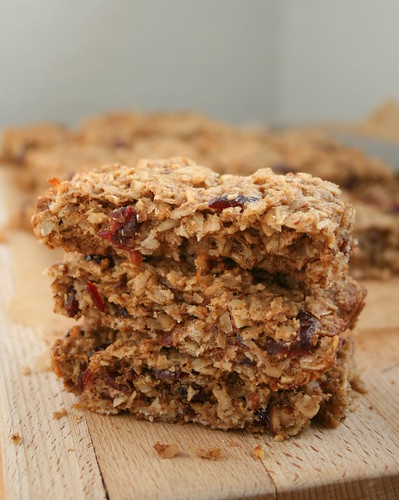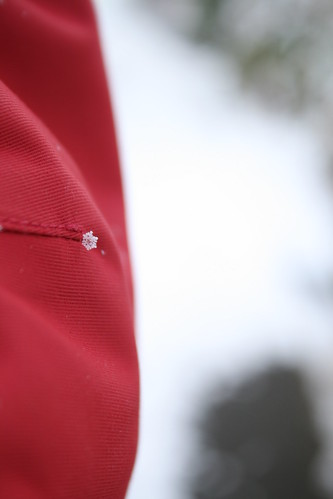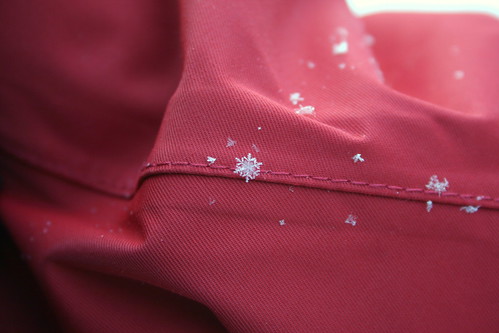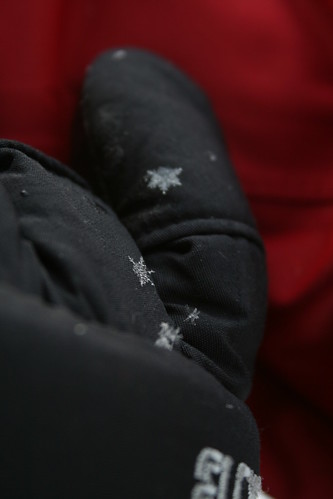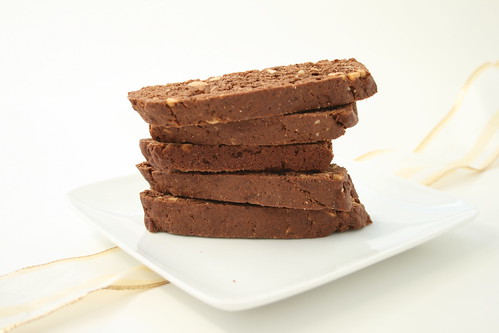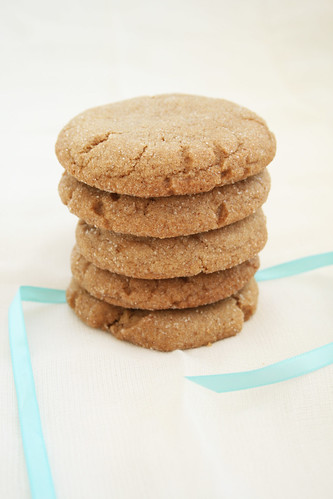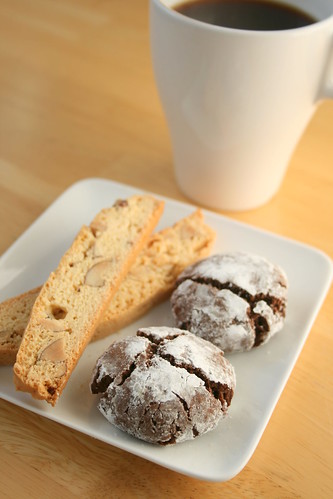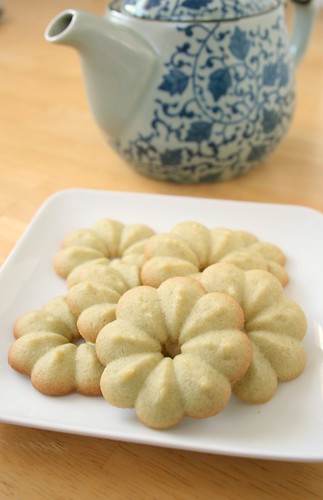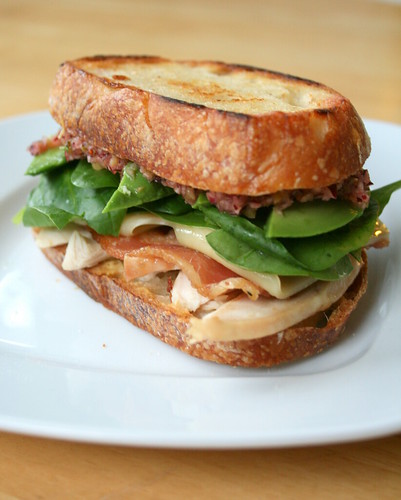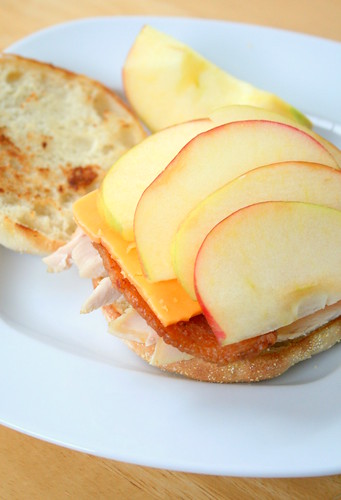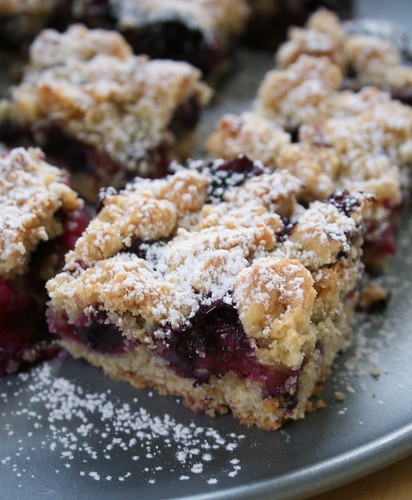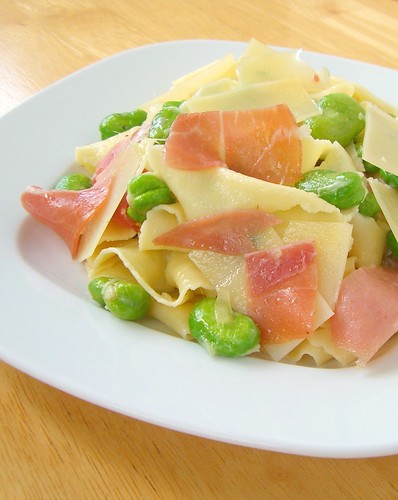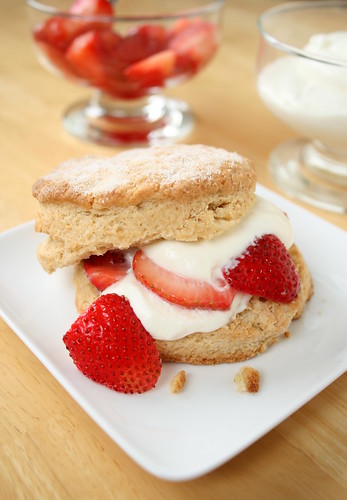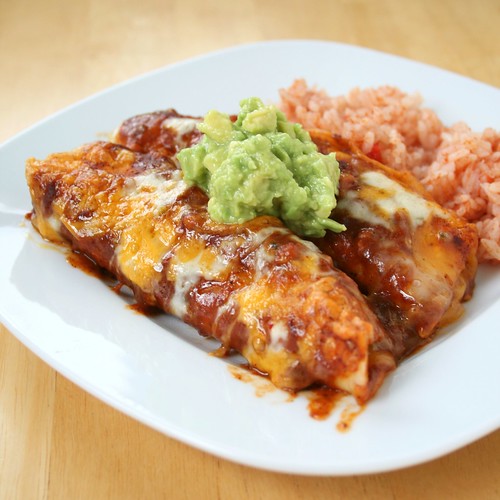
First off, I want to thank Margot of
Coffee and Vanilla and Maybelle's Mom of
Feeding Maybelle for alerting me that a certain website has been stealing my content.
Grr! That site
seems to be down at this moment but it's certainly on my radar now and I'll be keeping a close eye on them. Thank you both for bringing this to my attention because I honestly wouldn't have known about this if it weren't for you two awesome ladies so these eclairs are dedicated to you gals. The food blogging community is so great, it makes me feel warm and fuzzy inside. :)
It's the end of the month and that can only mean one thing - it's
Daring Baker time again! When our hosts Meeta (
What's for lunch Honey) and Tony (
Olive Juice) announced that our challenge this month would be
eclairs, I was totally psyched and ready to go. This challenge was right up my alley because I love working with pâte à choux dough. But this wasn't just any eclair recipe, this is the recipe by the
King of Pâtisserie,
Kitchen Emperor,
Picasso of Pastry, (okay I'll stop now)
Pierre Hermé. Okay, this is when I start getting butterflies in my stomach and a little intimidated.
The actual making of the dough went off without a hitch. The recipe called for one more egg than I normally use. I didn't have a pastry tip large enough to squeeze the dough into the eclair shape so I snipped the tip off a ziploc bag, which works just as well. However, I was a little confused by the baking directions, which said to prop the oven door open with a wooden spoon after baking 7 minutes. My usual standby recipe warns that opening the oven door during baking will cause the choux to deflate. After some debating, I went with my instincts and kept the oven door closed the whole time. I would have done the wooden spoon thing just to see what would happen if I hadn't been making the eclairs for a party. A part of me feels terrible for doubting the words of Pierre Herme but I certainly didn't want 20 collapsed eclairs and no eggs left in the fridge.
The pastry cream was also very straightforward and simple to make. But in my opinion, what makes this recipe really stand out is the chocolate glaze. The glaze is a 2 part process that involves first making a chocolate sauce, then using part of that chocolate sauce to make the glaze. I'm sure it would have been amazing but I didn't have enough time or chocolate to make the special sauce. Instead I just melted some chocolate, butter, heavy cream, and a little corn syrup and used that as my quick 1 minute glaze. *shrugs* Worked well enough.
The finished product was really delicious - I mean how can you go wrong with double the chocolate?

Notes:
- Pipe the dough so it is about 4 inches long and roughly 3/4 inch across. I think eclairs look best when they are slender and elegant. They start to look like donuts if they're too chubby.
- Personally, I felt like the baking time in the recipe was not sufficient. My eclairs started deflating when I took them out of the oven after 20 minutes. Luckily, I was able to salvage most of them by putting them back in the oven for another 5 - 10 minutes to finish baking and reinflate.
- If you've stored the pastry cream in the fridge overnight, take a spatula and mix it up a bit to loosen it before piping.
- Either use poke a hole in the eclair and use a special filling tip (the long skinny almost-needlelike one) on a pastry bag, or cut the eclair lengthwise but do not cut all the way through and spoon or pipe the filling inside. Keeping the pastry shell intact allows for easier dipping into the chocolate glaze.
- To glaze the eclairs, hold the eclairs upside down and dip the tops in the chocolate making sure to coat the surface evenly, let any excess drip off before turning right side up. This will only work if the glaze is thin enough.
- It's best to serve the eclairs as soon as you make them, but they will keep in the fridge for maybe 1 - 2 days (they can possibly keep longer but by then the choux will get soggy).
Pierre Hermé’s Chocolate Éclairs
Recipe from Chocolate Desserts by Pierre Hermé
(makes 20-24 Éclairs)
Choux Pastry
1/2 cup (125g) whole milk
1/2 cup (125g) water
1 stick (4 ounces; 115g) unsalted butter, cut into 8 pieces
1/4 teaspoon sugar
1/4 teaspoon salt
1 cup (140g) all-purpose flour
5 large eggs, at room temperature
Preheat your oven to 375 degrees F (190 degrees C). Divide the oven into thirds by
positioning the racks in the upper and lower half of the oven. Line two baking sheets with waxed or parchment paper.
In a heavy bottomed medium saucepan, bring the milk, water, butter, sugar and salt to the boil.
Once the mixture is at a rolling boil, add all of the flour at once, reduce the heat to medium and start to stir the mixture vigorously with a wooden spoon. The dough comes together very quickly. Do not worry if a slight crust forms at the bottom of the pan, it’s supposed to. You need to carry on stirring for a further 2-3 minutes to dry the dough. After this time the dough will be very soft and smooth.
Transfer the dough into a bowl of a mixer fitted with the paddle attachment, or using your handmixer or if you still have the energy, continue by hand. Add the eggs one at a time, beating after each egg has been added to incorporate it into the dough. You will notice that after you have added the first egg, the dough will separate, once again do not worry. As you keep working the dough, it will come back all together again by the time you have added the third egg. In the end the dough should be thick and shiny and when lifted it should fall back into the bowl in a ribbon.
The dough should be still warm. It is now ready to be used for the éclairs as directed above. Once the dough is made you need to shape it immediately. You can pipe the dough and the freeze it. Simply pipe the dough onto parchment-lined baking sheets and slide the sheets into the freezer. Once the dough is completely frozen, transfer the piped shapes into freezer bags. They can be kept in the freezer for up to a month.
Fill a large pastry bag fitted with a 2/3 (2cm) plain tip nozzle with the warm cream puff dough. Pipe the dough onto the baking sheets in long, 4 to 41/2 inches (about 11 cm) chubby fingers. Leave about 2 inches (5 cm) space in between each dough strip to allow them room to puff. The dough should give you enough to pipe 20-24 éclairs.
Slide both the baking sheets into the oven and bake for 15 minutes. After the 15 minutes, rotate the pans from top to bottom and front to back. Bake for 5 - 10 more minutes, or until the shells are golden brown and crisp. The éclairs can be kept in a cool, dry place for several hours before filling.
Chocolate Pastry Cream
2 cups (500g) whole milk
4 large egg yolks
6 tbsp (75g) sugar
3 tablespoons cornstarch, sifted
7 oz (200g) bittersweet chocolate, preferably Velrhona Guanaja, melted
2 1/2 tbsp (1¼ oz: 40g) unsalted butter, at room temperature
In a small saucepan, bring the milk to a boil. In the meantime, combine the yolks, sugar and cornstarch together and whisk in a heavy-bottomed saucepan.
Once the milk has reached a boil, temper the yolks by whisking a couple spoonfuls of the hot milk into the yolk mixture. Tempering the eggs raises the temperature of the eggs slowly so that they do not scramble.
Continue whisking and slowly pour the rest of the milk into the tempered yolk mixture.
Strain the mixture back into the saucepan to remove any egg that may have scrambled. Place the pan over medium heat and whisk vigorously (without stop) until the mixture returns to a boil. Keep whisking vigorously for 1 to 2 more minutes (still over medium heat).Stir in the melted chocolate and then remove the pan from the heat.
Scrape the pastry cream into a small bowl and set it in an ice‐water bath to stop the cooking process. Make sure to continue stirring the mixture at this point so that it remains smooth.
Once the cream has reached a temperature of 140 F remove from the ice‐water bath and stir in the butter in three or four installments. Return the cream to the ice‐water bath to continue cooling, stirring occasionally, until it has completely cooled. The cream is now ready to use or store in the fridge. The pastry cream can be made 2 - 3 days in advance and stored in the refrigerator. In order to avoid a skin forming on the pastry cream, cover with plastic wrap pressed onto the cream.
Chocolate Glaze (makes 1 cup or 300g)
1/3 cup (80g) heavy cream
3 1/2 oz (100g) bittersweet chocolate, finely chopped
4 tsp (20 g) unsalted butter, cut into 4 pieces, at room temperature
7 tbsp (110 g) Chocolate Sauce (recipe below), warm or at room temperature
In a small saucepan, bring the heavy cream to a boil. Remove from the heat and slowly begin to add the chocolate, stirring with a wooden spoon or spatula.
Stirring gently, stir in the butter, piece by piece followed by the chocolate sauce.
If the chocolate glaze is too cool (i.e. not liquid enough) you may heat it briefly in the microwave or over a double boiler. A double boiler is basically a bowl sitting over (not touching) simmering water.
It is best to glaze the eclairs after the glaze is made, but if you are pressed for time, you can make the glaze a couple days ahead of time, store it in the fridge and bring it up to the proper temperature (95 to 104 F) when ready to glaze.
Chocolate Sauce (makes 1 1/2 cups or 525 g)
4 1/2 oz (130 g) bittersweet chocolate, finely chopped
1 cup (250 g) water
1/2 cup (125 g) crème fraîche, or heavy cream
1/3 cup (70 g) sugar
Place all the ingredients into a heavy‐bottomed saucepan and bring to a boil, making sure to stir constantly. Then reduce the heat to low and continue stirring with a wooden spoon until the sauce thickens.
It may take 10 - 15 minutes for the sauce to thicken, but you will know when it is done when it coats the back of your spoon.
You can make this sauce ahead of time and store it in the refrigerator for two weeks. Reheat the sauce in a microwave oven or a double boiler before using. This sauce is also great for cakes, ice-cream and tarts.
Assembling the éclairs:
Slice the éclairs horizontally, lengthwise only on one side (do not cut all the way through), using a serrated knife and a gently sawing motion.
Pipe the pastry cream into the éclairs.
The glaze should be barely warm to the touch (between 95 – 104 degrees F or 35 – 40
degrees C, as measured on an instant read thermometer). Spread the glaze over the tops of the éclairs using a metal icing spatula. Or if your chocolate glaze is thin enough, dip the tops of the eclairs in the glaze and let the excess drip off then set aside to dry. and allow the tops to set. If you have chilled your chocolate glaze, reheat by placing it in a bowl over simmering water, stirring it gently with a wooden spoon. Do not stir too vigorously as you do not want to create bubbles.
The éclairs should be served as soon as they have been filled.

